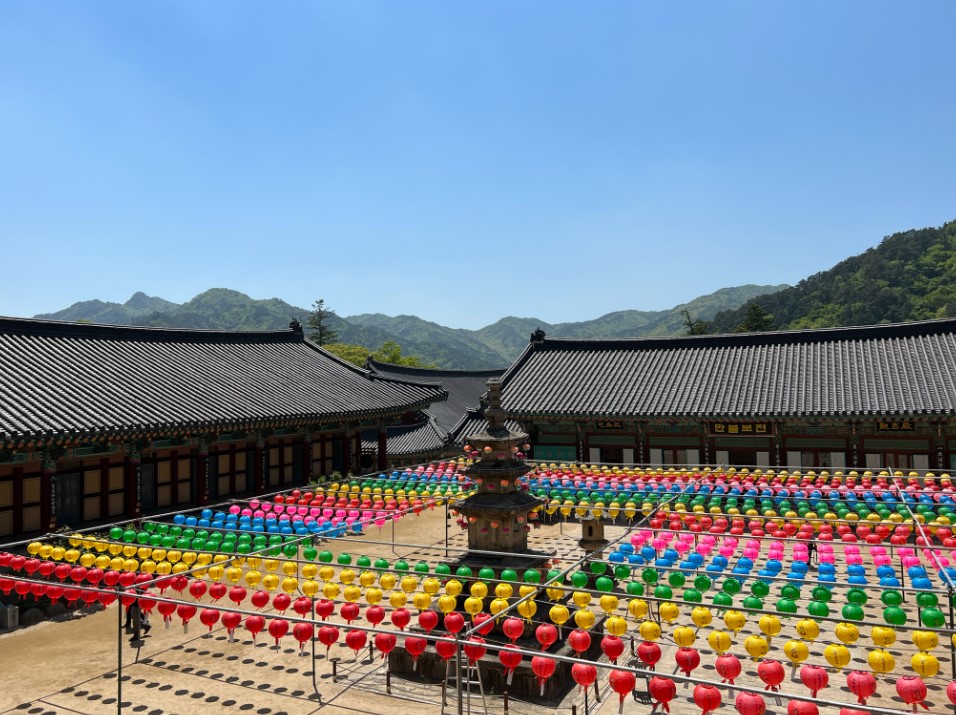

Haeinsa is not just a temple but a living monument to Korea’s spiritual and intellectual legacy. With its unparalleled cultural treasures, breathtaking natural setting, and opportunities for personal reflection, it offers a profound and memorable experience to visitors seeking both knowledge and serenity.
Location: 10 Chiin-ri, Gaya-myeon, Hapcheon-gun, Gyeongsangnam-do, South Korea
History:
Haeinsa Temple, meaning “Temple of the Reflection on a Smooth Sea,” is one of the most important and historic Buddhist temples in Korea. It was founded in 802 AD during the reign of King Aejang by two monks, Suneung and Ijung, to honor the queen, who was healed from an illness through the power of Buddhist teachings. The temple has served as a major center of Korean Buddhism for over 1,200 years and remains active to this day.
Cultural and Historical Significance
- Tripitaka Koreana (팔만대장경):
- Haeinsa is home to the Tripitaka Koreana, a collection of 81,258 wooden printing blocks inscribed with the entire Buddhist canon.
- Created during the 13th century to invoke divine protection against Mongol invasions, these blocks are the most complete and accurate collection of Buddhist texts in existence.
- Janggyeong Panjeon, the storage halls for the Tripitaka, are an architectural marvel, designed to naturally ventilate and preserve the woodblocks over centuries.
- One of Korea’s Three Jewel Temples (삼보사찰):
- Haeinsa represents the “Dharma Jewel” (법보사찰), symbolizing the Buddha’s teachings. Alongside Tongdosa (Buddha Jewel) and Songgwangsa (Sangha Jewel), Haeinsa plays a vital role in the spiritual landscape of Korea.
Main Attractions at Haeinsa Temple
- Janggyeong Panjeon (장경판전)
- This UNESCO-listed structure was built in the 15th century and serves as the storage hall for the Tripitaka Koreana.
- Ingeniously designed for natural ventilation, the building keeps the woodblocks free from moisture and pests, preserving them in pristine condition for over 800 years.
- Daejeokgwangjeon (대적광전, Hall of Great Silence and Light)
- The temple’s main prayer hall, housing a statue of Vairocana Buddha, symbolizing infinite light and wisdom.
- Iljumun (일주문, One Pillar Gate)
- The temple’s entrance gate represents the transition from the secular world to the spiritual realm. It is named “One Pillar Gate” because, when viewed from the side, it appears as if there is only one pillar, symbolizing non-duality.
- Temple Stay Programs
- Haeinsa offers immersive temple stay programs, where visitors can experience the life of monks through meditation, tea ceremonies, chanting, and simple communal meals.
- These programs allow foreigners and locals alike to connect with Korean Buddhist practices and find inner peace.
Natural Surroundings
- Haeinsa is situated within Gayasan National Park, offering spectacular mountain scenery. The park is known for its dense forests, hiking trails, and vibrant autumn foliage.
- Visitors can explore trails leading to Mount Gaya’s peaks, which provide breathtaking views and add to the spiritual ambiance of the temple.
Why Visit Haeinsa?
- Preserving History and Heritage:
The Tripitaka Koreana is a testament to Korea’s cultural dedication to Buddhism and academic excellence, making Haeinsa a must-visit destination for history enthusiasts. - Architectural Marvel:
The Janggyeong Panjeon storage halls demonstrate advanced architectural techniques used to preserve priceless heritage for centuries. It is a symbol of Korea’s innovation and respect for knowledge. - Spiritual Retreat:
The peaceful environment of the temple, coupled with its temple stay programs, offers visitors an opportunity for mindfulness and reflection, making it an ideal place to disconnect from the modern world.
Tips for Visitors
- Transportation:
- Haeinsa is accessible by bus from Daegu or Hapcheon. Visitors can also take a taxi from the nearby city of Hapcheon.
- Plan for a Full Day or Overnight Stay:
- To fully appreciate the temple’s offerings and explore the surrounding national park, consider spending a full day or joining a temple stay program.
- Dress Comfortably:
- As the temple grounds are extensive and hiking trails are available, wearing comfortable shoes and clothing is recommended.
